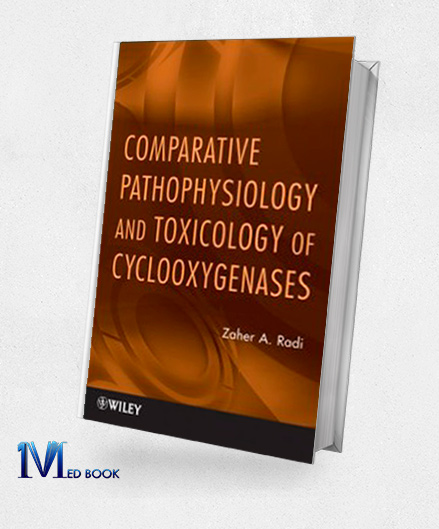Comparative Pathophysiology and Toxicology of Cyclooxygenases (Original PDF from Publisher)
Comparative Pathophysiology and Toxicology of Cyclooxygenases (Original PDF from Publisher)
$135.00 Original price was: $135.00.$24.00Current price is: $24.00.
- The files will be sent to you via E-mail
- Once you placed your order, we will make sure that you receive the files as soon as possible
Comparative Pathophysiology and Toxicology of Cyclooxygenases (Original PDF from Publisher)
Cyclooxygenases (COXs) constitute a group of enzymes accountable for the synthesis of vital biological mediators recognized as prostanoids. These prostanoids, including prostaglandins, orchestrate pivotal roles in the orchestration of inflammatory responses and anaphylactic reactions.
In the pursuit of ameliorating inflammation and pain, the strategic inhibition of COXs through non-steroidal anti-inflammatory drugs (NSAIDs), exemplified by the likes of ibuprofen, emerges as a viable therapeutic approach.
Nonetheless, the utilization of NSAIDs is not devoid of potential perils, as these agents harbor the capacity to incite adverse physiological outcomes.
The work entitled “Comparative Pathophysiology and Toxicology of Cyclooxygenases” holistically examines the intricate panorama of the impact wrought by COX inhibitors across diverse physiological systems, specifically elucidating the underpinnings of toxicity ensuing from COX enzyme inhibition.
This opus commences by laying a foundation, offering insights into the historical backdrop and the therapeutic utilization of cyclooxygenases.

Comparative Pathophysiology and Toxicology of Cyclooxygenases (Original PDF from Publisher)
It delves into the variances in COX inhibitor expression, pathophysiological processes, and toxicological responses across various species.
With meticulous rigor, this treatise systematically dissects the effects and pathophysiological cascades activated by COX inhibitors, with a primary focus on the gastrointestinal (GI) tract. Subsequent sections expound upon:
- The pathophysiological implications of COX inhibition on the recuperation of bone, tendons, and ligaments.
- COX inhibitors’ ramifications on renal system pathophysiology and the intricate mechanisms of ensuing toxicity.
- The contributory role of COX inhibition in ocular system pathophysiology.
- COX inhibitors’ impact on the respiratory and cardiovascular systems.
Furthermore, this compendium cast illumination on contemporary investigations and advancements dedicated to the formulation of COX inhibitors devoid of deleterious side-effects.
Pioneering in its approach, this seminal work emerges as the foremost endeavor delving comprehensively into the comparative evaluation of the toxicological repercussions of COX inhibitors across the entirety of the human body. In doing so, it strives to propel the advancement of research and the evolution of safer and more efficacious COX-targeted pharmaceutical agents.
1.2.Key Features
The foremost key features of “Comparative Pathophysiology and Toxicology of Cyclooxygenases” encompass a comprehensive exploration of the effects, mechanisms, and potential advancements in the realm of COX inhibitors. This seminal work stands out due to the following distinguishing attributes:
- Holistic Comparative Analysis: Comparative Pathophysiology and Toxicology of Cyclooxygenases offers an in-depth and systematic comparison of the toxicological effects of COX inhibitors across various physiological systems, shedding light on the variations in expression, pathophysiology, and toxicological responses among different species.
- Multi-dimensional Approach: By traversing diverse bodily systems, the book provides a multi-dimensional understanding of how COX inhibitors impact not only the GI tract but also bone, tendon, ligament healing, the renal system, the ocular system, as well as the respiratory and cardiovascular systems.
- Historical and Therapeutic Context: Comparative Pathophysiology and Toxicology of Cyclooxygenases elucidates the historical background and therapeutic applications of cyclooxygenases, framing the discussion within the broader context of their significance in mediating inflammatory responses and offering relief through pharmacological intervention.
- Toxicological Mechanisms Unveiled: Comparative Pathophysiology and Toxicology of Cyclooxygenases delves deep into the mechanisms by which COX inhibitors exert their toxicity, unraveling the intricate pathways and processes that underlie adverse effects, thereby contributing to a more profound understanding of their potential risks.
- Cutting-edge Research: The work provides insights into the latest research endeavors aimed at developing COX inhibitors that circumvent adverse side effects, highlighting the ongoing efforts to create safer and more effective therapeutic options.
- Pathophysiological Insights: Comparative Pathophysiology and Toxicology of Cyclooxygenases not only outlines the adverse effects but also elucidates the pathophysiological implications of COX inhibition in various systems, enhancing the reader’s comprehension of the underlying physiological changes that occur.
- Potential for Safer Drug Development: By synthesizing the current knowledge on COX inhibitors’ toxicological effects, the book paves the way for the advancement of research and development of pharmaceutical agents that target COX with enhanced safety profiles.
- Interdisciplinary Scope: This work bridges the gap between pharmacology, toxicology, and comparative physiology, making it a valuable resource for researchers, pharmacologists, toxicologists, and healthcare professionals seeking a comprehensive understanding of COX inhibitors’ effects.

Comparative Pathophysiology and Toxicology of Cyclooxygenases
In essence, “Comparative Pathophysiology and Toxicology of Cyclooxygenases” stands as a pivotal reference that amalgamates scientific rigor with a broader contextual understanding, making it an indispensable tool for advancing knowledge in the domain of COX inhibitors and their implications for human health.
1.3. About Writer
Zaher A. Radi is a distinguished author renowned for his significant contributions in the fields of pharmacology and toxicology.
With a solid academic background, Radi earned a Ph.D. in Pharmacology, showcasing his commitment to advancing scientific understanding.
He has garnered acclaim for his research focusing on cyclooxygenases (COXs) and their inhibitors, a subject of paramount importance in the realm of inflammation and pain management.
Radi’s seminal work, “Comparative Pathophysiology and Toxicology of Cyclooxygenases,” stands as a testament to his expertise.
Through this comprehensive study, Radi has unravelled the intricate mechanisms underlying the effects of COX inhibitors across diverse physiological systems, enlightening the scientific community about potential risks and avenues for safer drug development.
His achievements extend to pioneering research on safer therapeutic agents, and his interdisciplinary approach bridges the gap between pharmacology and toxicology.
Radi’s scholarly endeavors have significantly advanced our understanding of COX inhibitors’ impact, leaving an indelible mark on the field and offering valuable insights into improving drug efficacy and safety.

Comparative Pathophysiology and Toxicology of Cyclooxygenases (Original PDF from Publisher)
Summary
“Comparative Pathophysiology and Toxicology of Cyclooxygenases” is a seminal work by Zaher A. Radi that offers a comprehensive exploration of the intricate effects and mechanisms associated with cyclooxygenase (COX) inhibitors.
Through a meticulous comparative analysis across various physiological systems, the book unveils the diverse repercussions of COX inhibition, spanning from the gastrointestinal tract to bone healing, renal function, ocular health, and cardiovascular and respiratory systems.
By delving into historical contexts, toxicological pathways, and the latest research endeavors, the book bridges disciplines of pharmacology and toxicology, presenting a holistic perspective on COX inhibitors’ therapeutic benefits and potential risks.
It serves as an invaluable resource for researchers, pharmacologists, and healthcare professionals aiming to enhance the understanding of COX-targeted therapies and advance the development of safer and more effective pharmaceutical agents.
Make sure that you are buying e-books from trustworthy sources. With over a decade of experience in the e-book industry, the Medbook1.com website is a reliable option for your purchase.
Categories:
Other Products:
Clinically Oriented Anatomy 7th Edition (Original PDF from Publisher)
Clinical Electrophysiology Review Second Edition (Original PDF from Publisher)
Clinical Anatomy A Case Study Approach (Original PDF from Publisher)
Connexin Cell Communication Channels Roles in the Immune System and Immunopathology
Endocrine Physiology Fourth Edition (Lange Physiology Series)



Reviews
There are no reviews yet.